Legion of Honor (museum)
|
| |
 Location within San Francisco | |
| Location | 100 34th Avenue, San Francisco, California, United States of America |
|---|---|
| Coordinates | 37°47′02″N 122°30′04″W / 37.78389°N 122.50111°WCoordinates: 37°47′02″N 122°30′04″W / 37.78389°N 122.50111°W |
| Type | Art museum |
| Visitors | 177,608 (2010) [1] |
| Public transit access | San Francisco Municipal Railway |
| Website | http://legionofhonor.famsf.org/ |
The Legion of Honor (formerly known as The California Palace of the Legion of Honor) is a part of the Fine Arts Museums of San Francisco[2] (FAMSF). The name is used both for the museum collection and for the building in which it is housed. On March 22, 2016, the Fine Arts Museums of San Francisco announced the appointment of Max Hollein as its director, taking over from Colin Bailey who left for the Morgan Library & Museum after a two-year term. Hollein's tenure began on June 1, 2016.[3]
History
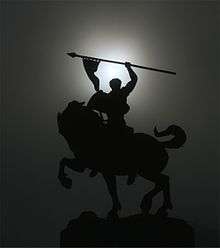
The Legion of Honor was the gift of Alma de Bretteville Spreckels, wife of the sugar magnate and thoroughbred racehorse owner/breeder Adolph B. Spreckels.[4] The building is a full-scale replica, by George Applegarth and H. Guillaume, of the French Pavilion at the 1915 Panama–Pacific International Exposition, which in turn was a three-quarter-scale version of the Palais de la Légion d'Honneur also known as the Hôtel de Salm in Paris, by Pierre Rousseau (1782). At the close of the exposition, which was located just a few miles away, the French government granted Spreckels permission to construct a permanent replica of the French Pavilion, but World War I delayed the groundbreaking until 1921.[5]
The museum building occupies an elevated site in Lincoln Park in the northwest of the city, with views over the Golden Gate Bridge. Most of the surrounding Lincoln Park Golf Course is on the site of a potter's field called the "Golden Gate Cemetery" that the City had bought in 1867. The cemetery was closed in 1908 and the bodies were relocated to Colma. During seismic retrofitting in the 1990s, however, coffins and skeletal remains were unearthed.[6]
The plaza and fountain in front of the Palace of the Legion of Honor is the western terminus of the Lincoln Highway, the first improved road for automobiles across America. The terminus marker and an interpretive plaque are located in the southwest corner of the plaza and fountain, just to the left of the Palace. Dominating the Classical plaza is "Pax Jerusalemme," a modern sculpture by Mark di Suvero, widely criticized as plop art.[7][8]
Collections
The Legion of Honor displays a collection spanning more than 6,000 years of ancient and European art and houses the Achenbach Foundation for Graphic Arts in a neoclassical building overlooking Lincoln Park and the Golden Gate Bridge.
- European Art
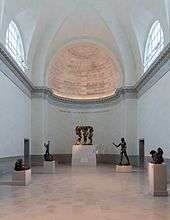
The museum contains a representative collection of European art, the largest portion of which is French. Its most distinguished collection is of sculpture by Auguste Rodin. Casts of some of his most famous works are on display, including one of The Thinker in the Court of Honor. However, there are individual works by many other artists, including François Boucher, Rembrandt, Gainsborough, David, El Greco, Giambattista Pittoni, Rubens, and many of the Impressionists and post-Impressionists—Degas, Renoir, Monet, Pissarro, Seurat, Cézanne and others. There are also representative works by key 20th century figures such as Braque and Picasso, and works of contemporary artists like Gottfried Helnwein and Robert Crumb.
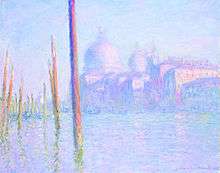
- Collection Highlights
- Icon of Saints John the Baptist and Minias, Bicci di Lorenzo (15th century)
- St. Francis Venerating the Crucifix, El Greco, 1595
- St. John the Baptist, El Greco, 1600
- The Tribute Money, Rubens, 1612
- Descent from the Cross, Giambattista Pittoni, 1750
- The Age of Bronze, Auguste Rodin, 1875
- Trotting Horse Edgar Degas, 1881
- The Kiss, Auguste Rodin, 1884
- The Grand Canal, Claude Monet, 1908
- Waterlilies, Claude Monet, 1914
Symphonic organ
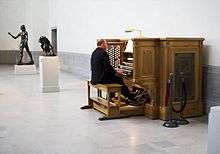
In 1924, John D. Spreckels commissioned the Ernest M. Skinner Company of Boston to build the symphonic organ. The museum organ, which is housed inside the museum above the main galleries, has 4 manuals and pedals, 7 divisions, 63 ranks, with a total of 4,526 pipes. Symphonic music is especially effective on the museum organ with its battery of pneumatically operated percussion instruments and set of tubular chimes. A thunder pedal is used for the musical representation of storms. All together, the organ comprises one Great Organ, a Swell Organ, a Choir Organ featuring a 16-foot Contra Dulciana, Choir Organ Echo, a Solo Organ, Solo Organ Echo, an Arch Organ outfitted with 8-foot Arch Clarion, a 64-foot Gravissima and a 32-foot Bourdon Profunda, in addition to the final Traps that were enclosed in the Choir: Bass drum, castanets, Chinese block, crash cymbal, gong snare drum (f), snare drum (ff), and a tambourine triangle.
Gallery
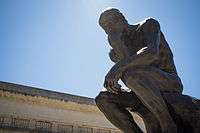 Statue of The Thinker by Auguste Rodin in the front of the museum.
Statue of The Thinker by Auguste Rodin in the front of the museum.- Fountain in the front.
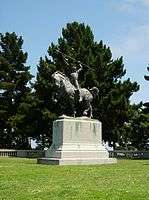
 Joan of Arc on horseback.
Joan of Arc on horseback.- Female side of Aesthetic teapot designed by R. W. Binns and modeled by James Hadley, 1881.
- 17th century Oak Table (Italy) & World Globes (Netherlands)
Film appearances
- The Palace is seen in the Alfred Hitchcock movie Vertigo (1958) when Scottie follows Madeleine Elster to the museum, where she stares at one painting for a considerable time. This painting, the one dubbed 'Beautiful Carlotta' was a prop created specifically for the production and is not housed at the museum.
- The Palace appears in the Tales of the City (TV miniseries) based on the first of the Tales of the City series of novels by Armistead Maupin. The character of Mary Ann Singleton (played by Laura Linney) arranges to meet her neighbor Norman Neal Williams (played by Stanley DeSantis) at the museum, where he meets his fate.
- The character Dr. Crippen in the spoof Maltese Falcon sequel The Black Bird has an office in the Palace.
See also
References
- ↑ "Exhibition and museum attendance figures 2010" (PDF). London: The Art Newspaper. April 2011. Retrieved 11 April 2011.
- ↑ "Fine Arts Museums San Francisco". legionofhonor.famsf.org.
- ↑ Jori Finkel (22 March 2016). "Fine Arts Museums in San Francisco Picks Max Hollein as Next Director". The New York Times. Retrieved 23 March 2016.
In a surprising move, the Fine Arts Museums of San Francisco has gone beyond the United States for its next director, hiring Max Hollein away from the Städel Museum in Frankfurt.
- ↑ "About ArtPoint". Archived from the original on 2008-06-25. Retrieved 2008-12-12.
- ↑ "History of California Palace of the Legion of Honor".
- ↑ Sullivan, Kathleen (1995-01-19). "Remains of S.F. pioneers are laid to new, final rest". San Francisco Examiner. Retrieved 2007-02-08.
- ↑ "A Legion of Concerns Over Sculpture / Di Suvero's mediocre `Pax Jerusalem' may signal a troubling trend at Fine Arts Museums". San Francisco Chronicle.
- ↑ http://www.artnet.com/magazineus/reviews/robinson/the-legion-of-honor3-30-10.asp. Missing or empty
|title=(help)
External links
| Wikimedia Commons has media related to California Palace of the Legion of Honor. |